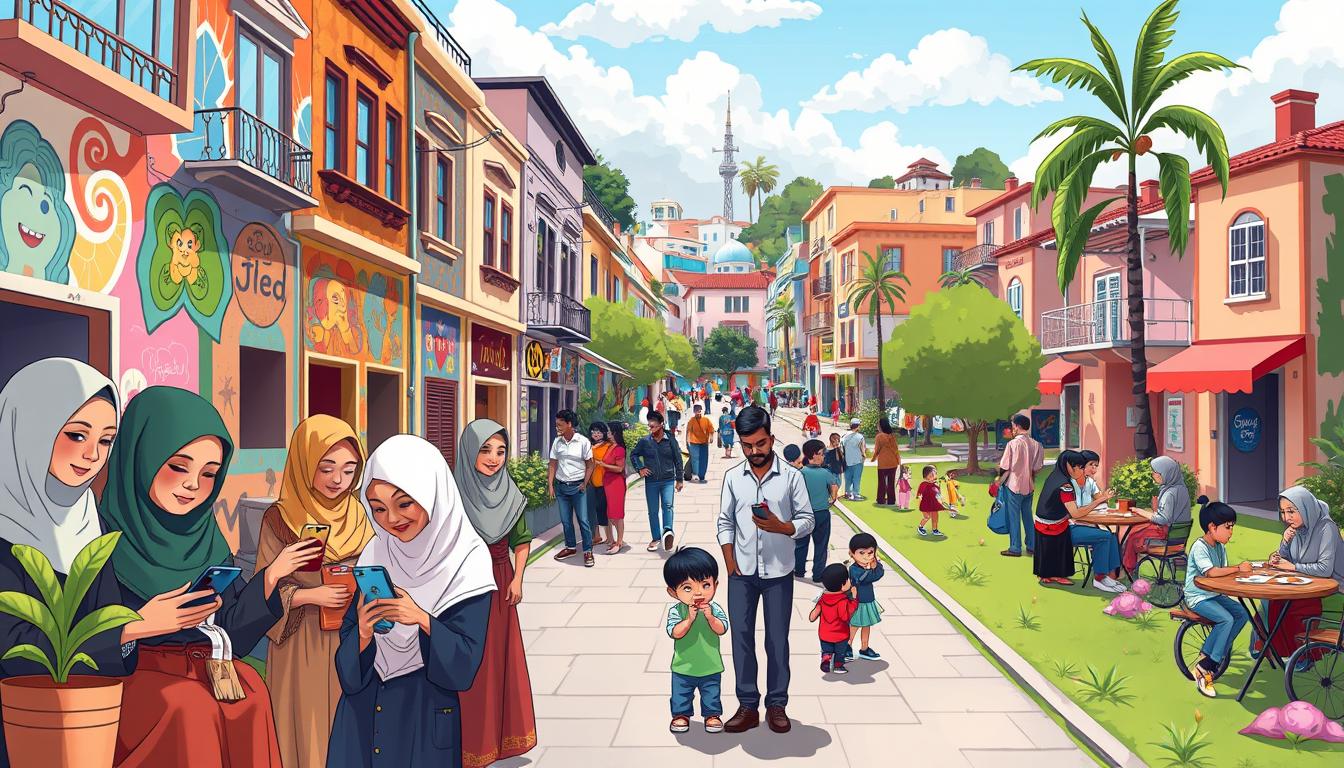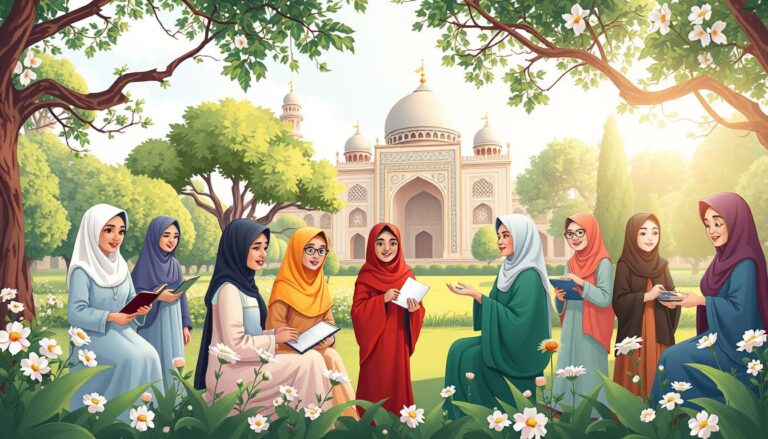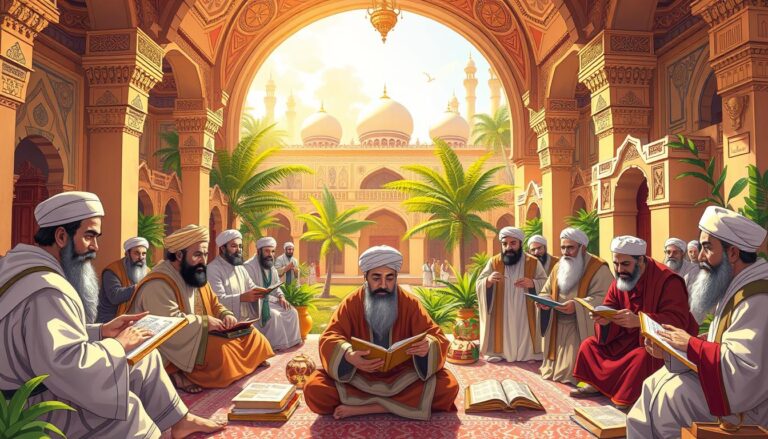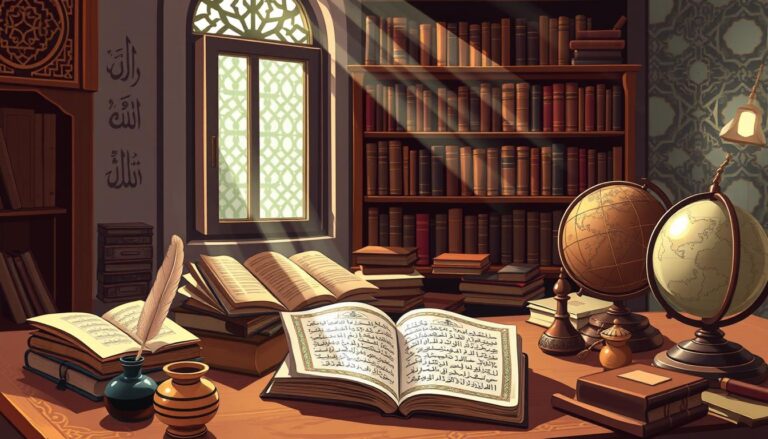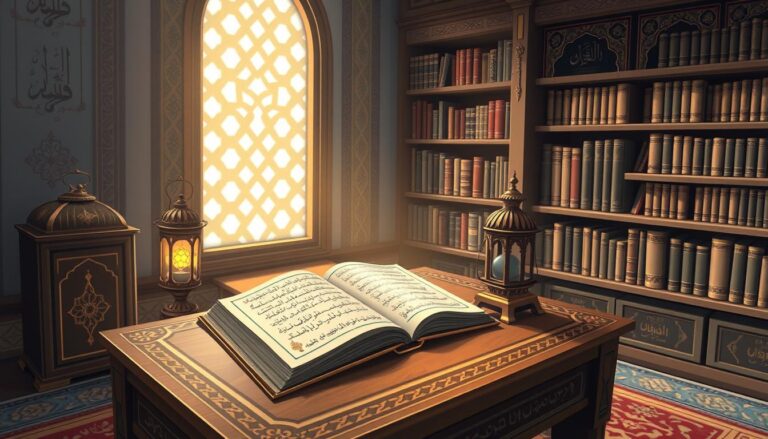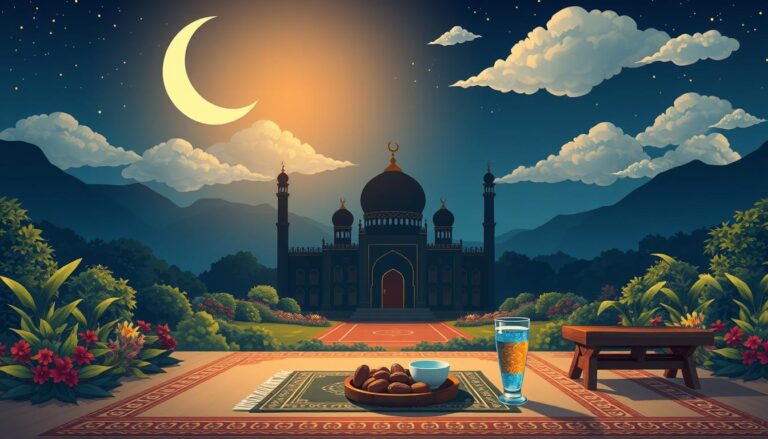Islam in the 21st Century: Trends and Changes
Can Islam thrive in today’s fast-changing world? This is a big question for Muslim society. With over 350 million followers, Islam is facing both challenges and chances in the 21st century.
The Islamic faith, with its long history, now deals with new tech and changing cultures. Muslim communities around the world are influenced by different cultures. This shapes their religious practices and Islamic identity.
Globalization brings both good and bad to Islamic communities. It helps in understanding and connecting, but also makes it hard to keep traditional values. Muslims are trying to find a balance between progress and staying true to their faith.
Key Takeaways
- Islam has over 350 million followers in the 21st century
- Muslim society faces challenges in adapting to globalization
- Preserving Islamic identity while embracing modern trends is crucial
- Globalization offers opportunities for greater understanding of Islam
- Muslim communities are spread across diverse cultures and continents
Understanding Islam in the Modern World
Islam is a universal religion with over 1.6 billion followers. It plays a big role in shaping our global society. It’s the world’s second-largest faith, affecting international trade, human rights, and politics.
Islamic principles guide believers to live their lives fully. They focus on their relationship with God and the world around them.
Defining Islam in Contemporary Context
Muslims call their faith “Islam,” which means submission to Allah and peace. Islamic principles teach justice and proper conduct in all life aspects. The faith has many traditions, like Sunni, Shia, and Sufi.
Global Muslim Population and Distribution
Muslims are found all over the world. Indonesia, the largest Muslim-majority country, follows Pancasila. Other big Muslim centers are Pakistan, Bangladesh, India, and Malaysia.
Saudi Arabia is the economic heart of the ummah because of its oil wealth.
The Impact of Globalization on Islamic Societies
Globalization brings both challenges and opportunities to Islamic societies. Muslims must balance modern life with traditional values. They need to reinterpret Islamic principles and encourage critical thinking.
It’s important to integrate modern knowledge without just relying on Western ideas. This is key for Muslim communities.
“To gain a happy life in the hereafter, Islam requires believers to deal justly in social interactions and integrate every aspect of life.”
To understand Islam today, we must see its diversity. We must also recognize its global impact. And we need to appreciate the mix of tradition and modern challenges.
The Challenges Facing Muslims Today
Muslims around the world face big challenges today. They struggle to keep their Islamic identity while living in modern times. This balance often creates tension between old values and new ways.
Media often gets Islam wrong, leading to bad ideas about it. A 2021 survey showed 48% of Muslim Americans faced religious bias. This makes life hard for them and makes it tough to fit into society.
Secularization is another big issue. As places become less religious, keeping traditions alive gets harder. This change affects how Muslims practice their faith and how they stick together as a community.
- Socioeconomic decline in Muslim countries
- Sectarianism within Muslim communities
- Adapting Islamic teachings to modern contexts
Extremism has hurt Islam’s image worldwide. It makes people watch Muslim communities more closely and makes it harder for different faiths to get along. Muslims need to fight against these extreme views to keep their faith real.
“Islam teaches peace and tolerance. We must stand united against those who distort our religion for their own agenda.”
But many Muslims are trying to make Islam fit for today. They want to tackle today’s problems while staying true to Islamic values. This effort to adapt and think deeply is key for Islam to stay relevant in our fast-changing world.
Islamic Identity in a Globalized World
In today’s world, Muslims must keep their Islamic traditions alive while moving forward. With nearly 1.2 billion followers, Islam is a big part of many communities. It’s a balance between keeping faith strong and fitting into today’s world.
Preserving Traditions in Modern Times
Muslims work hard to keep their faith alive in a world that’s always changing. Prayer, fasting, and giving to charity are key parts of being Muslim. But, issues like political problems and economic struggles make it hard.
Adapting Islamic Practices to Contemporary Life
Technology has changed how Muslims practice their faith. The internet lets people learn more about Islam and connect with others. Young Muslims use social media to share their beliefs and join global talks.
The Role of Technology in Shaping Muslim Identity
Technology is very important for Muslim identity today. Apps help with daily prayers and reading the Quran. Online forums and virtual mosques also play a big role. They help Muslims stay true to their faith in today’s world.
“Islam is not just a religion, but a way of life that adapts to changing times while preserving its core values.”
Muslims face big challenges in the 21st century. But, they can keep their faith strong by blending tradition with modern life. This is key to keeping their identity in our global world.
Islamic Reformation and Modernization
Islamic reform movements are growing, aiming to tackle today’s issues while keeping key religious values. This effort has sparked debates between those who stick to tradition and those who want change. Each side has its own view of what Islam teaches.
Modernist views of Islam aim to update religious practices for the 21st century. For instance, the Ottoman Empire’s Tanzimat reforms (1839-1876) brought in European ways. This led to new ideas in science and law.
Religious reformers focus on adapting Islamic teachings for today’s world. They want to make Islam relevant in our times without losing its core beliefs. This is important as the world changes and globalization grows.
- Emphasis on tajdid (renewal) using the Qur’an as a foundation
- Promotion of scientific freedom and separation of powers
- Efforts to establish Islamic states and revitalize Islamic teachings
In Azerbaijan, women got the right to vote in 1918, before many European countries. This shows how Islamic reform can lead to big social gains in Muslim-majority countries.
“Islamic reformation involves reinterpreting religious texts and practices to address contemporary challenges while maintaining core principles.”
The Muslim world is facing the challenges of the 21st century. The debate between tradition and modernity is key. Islamic reform and modernization aim to find a balance between keeping religious identity and adapting to a changing world.
The Rise of Islamic Feminism and Women’s Rights
Islamic feminism has grown in recent years. It challenges old views of religious texts and fights for gender equality. This movement wants to change how Muslim women are seen in society and protect their rights.
Reinterpreting Islamic Texts from a Feminist Perspective
Muslim women scholars are working hard to look at religious texts in a new way. Amina Wadud is a key figure in this effort. She has helped us see the Qur’an from a woman’s point of view.
Her work questions old views that kept women out of Qur’anic studies.
Muslim Women in Leadership Roles
Islamic feminism has opened doors for Muslim women in leadership. In Egypt, women from the middle class started to play a bigger role in government. They helped grow women’s groups that supported the government.
Today, Muslim women are making their mark in politics, business, and education.
Challenges and Progress in Gender Equality
Even with progress, there are still big challenges to gender equality in Islamic societies. Old views of religious texts often slow down progress. For example, in Egypt, new changes to the Personal Status Law have caused a lot of debate.
Some changes aim to give women more rights, like the right to divorce without their husband’s consent. But, groups like the Muslim Brotherhood are against these changes.
“Any new reforms to the Personal Status Law should reflect societal culture while guaranteeing rights for both men and women.” – President Abdel-Fattah Al-Sisi
Islamic feminism keeps growing, with Muslim women leading the fight for equality. By looking at religious texts in a new way and challenging old norms, they are changing how we see women’s rights in Islamic societies.
Islam and Religious Pluralism in the 21st Century
The 21st century has brought more religious tolerance and dialogue in Islamic communities. Islam is now the world’s fastest-growing major religion, with 1.8 billion followers as of 2015. This growth has increased Islamic diversity, making open communication between faiths more important.
In the United States, Muslims make up 1.1% of the population. Views towards Muslims have improved since 2014. This shows a growing acceptance and understanding of Islamic diversity. The Muslim population in the U.S. is expected to reach 2.1% by 2050, making them the second-largest faith group.
Interfaith dialogue is key to fostering religious tolerance. Many Muslim-majority countries are talking with other faiths to promote understanding and peace. This aligns with Islamic teachings that value respect for other religions.
“The beauty of religious pluralism lies in its ability to bring diverse communities together, fostering a shared sense of humanity.”
Religious pluralism within Islam is also growing. Different schools of thought and interpretations exist, showing the rich diversity of Islam. This internal dialogue makes Islam more inclusive and adaptable in today’s world.
- 62% of Muslims live in the Asia-Pacific region
- Indonesia has the largest Muslim population globally
- By 2050, 10% of Europeans are expected to be Muslims
As Islam grows and evolves in the 21st century, interfaith dialogue and tolerance are crucial. This approach not only enriches Islamic communities but also helps achieve global peace and understanding.
The Evolution of Islamic Art and Culture
Islamic art and Muslim culture have seen big changes in the 21st century. This shows how dynamic modern Muslim societies are. They interact with global trends in exciting ways.
Contemporary Islamic Architecture
Modern Islamic architecture mixes old traditions with new designs. Architects like Hassan Fathy have led the way. They blend local customs with modern methods.
The Aga Khan Award for Architecture supports innovative designs in Muslim areas. It encourages fresh views on Islamic architecture.
Modern Muslim Music and Literature
Muslim artists are making a big impact globally. Their music and literature draw from Islamic traditions but also embrace modern styles. Persian poetry, for example, explores both worldly and divine themes, sometimes with a political edge.
- Sufi music gains popularity worldwide
- Muslim authors tackle contemporary issues in novels
- Islamic calligraphy finds new life in digital art
Islamic Fashion in the Global Market
Islamic fashion is becoming a big deal globally. Designers are creating clothes that are modest yet stylish. This appeals to Muslim consumers everywhere.
This trend shows Islamic art adapting to today’s tastes while keeping cultural values alive.
Islamic art is not static; it’s a living, breathing form of expression that continues to evolve with time.
Islamic art and culture are finding new ways to show timeless values in a fast-changing world. These modern expressions show the strength and flexibility of Muslim artistic traditions.
Islam in the 21st Century: Trends and Changes
The 21st century has seen big changes in modern Muslim society. Islamic reform is changing old ways while keeping core beliefs. Global trends are shaping how Muslims live their faith in today’s fast-paced world.
Education is now a big focus in Islamic communities. Many Muslims are learning more than just religious studies. They’re studying science and technology too. This change is making Muslim societies grow and innovate.
Technology is changing how Muslims practice their faith. They use apps for prayer times and Quran recitation. Social media is also helping Muslims talk about their faith and connect with others worldwide.
- 88.7% of people worldwide profess a religion in 2020
- Christians and Muslims represent 57% of the global population
- South Asia is home to almost a third of the Muslim population worldwide
Islamic reform is tackling big issues like climate change. Many Muslim leaders are pushing for caring for the environment based on Islamic teachings. This green approach is becoming more popular in Muslim-majority countries.
“Islam merges modernity with traditional practices, appealing to a diverse range of followers.”
The role of women in Islam is changing too. More Muslim women are becoming leaders in different fields. They’re looking at Islamic texts from a feminist view, fighting for gender equality in religious settings.
These changes show a vibrant Islam, adapting to today’s world while staying true to its roots. As global trends keep shaping Muslim societies, Islamic reform will likely stay a big part of 21st-century Islam.
Conclusion
Looking ahead, Islam is evolving to tackle 21st-century challenges. Muslims around the world are using new tech and ideas while keeping their faith strong. This mix of old and new is deeply changing how Islam impacts the globe.
Muslims are adding to science, art, and culture in big ways. They’re creating stunning Islamic buildings and setting fashion trends. They’re also working on issues like gender equality and religious diversity, showing they’re open to change.
The future of Islam is full of life and variety. Muslims are figuring out how to share their faith in the digital world. Despite hurdles, their strength and creativity point to a promising future. Islam will keep being a key player in our connected world.
Source Links
- Islam Past and Present
- The Future of World Religions: Population Growth Projections, 2010-2050
- Muslims
- Islam and Modern Trends | Religious Studies Center
- Islam and its Challenges in the Modern World
- Islam in the Modern World
- Microsoft Word – OIC 10 Year Programme of Action English.doc
- Muslims are a growing presence in U.S., but still face negative views from the public
- Major Themes – Islam And The West | Muslims | FRONTLINE
- Islam and Muslims in the 21st Century: A Call for Reflection, Rethinking, and Action
- Internationale Politik und Gesellschaft
- Where is my Islam? The identity crisis of 21st century Muslims | CNN
- Islam and modernity
- Modernity, Its Impact on Muslim World and General Characteristics of 19–20th-Century Revivalist–Reformists’ Re-Reading of the Qur’an
- Modernity, Its Crisis and Islamic Revivalism
- Women’s Rights and Islamic Feminism in Egypt – Georgetown Journal of International Affairs
- Women and the Qur’an: Feminist Interpretive Authority?
- Muslims and Islam: Key findings in the U.S. and around the world
- The World’s Muslims: Religion, Politics and Society
- The Nature of Islamic Art | Essay | The Metropolitan Museum of Art | Heilbrunn Timeline of Art History
- Islamic arts | Characteristics, Calligraphy, Paintings, & Architecture | Britannica
- Islamic arts – European Influence, Contemporary Trends | Britannica
- Sufism in the 21st Century Islam
- Three unexpected trends in religion – Gordon Conwell
- Microsoft Word – Zaman.docx
- From Both Sides Now: Reflections on Recent Methodological Trends in the Study of Islam
- Islamic Ethics and The Rise of Digital Technology – Maydan

